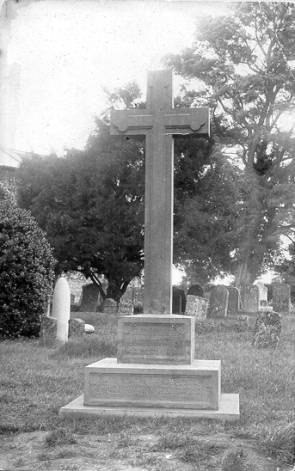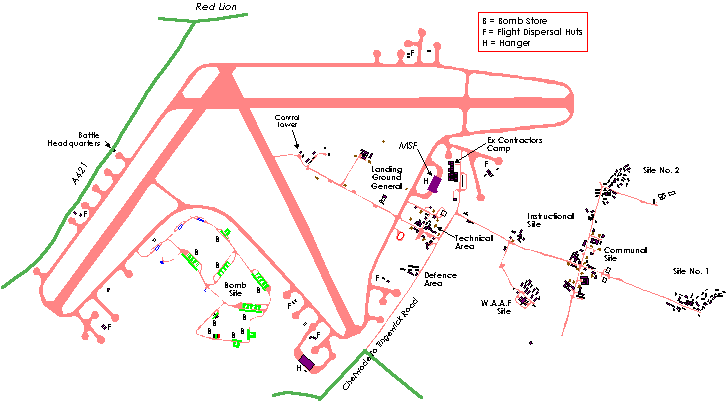
Finmere at War
Newsletter 6: November 1997.
The Armistice
On Nov. 11th at 11am an Armistice was concluded and the Great European War 1914-1918 came to an end.
The Reverend George Dangerfield, Rector of Finmere, recorded the end of the First World War with these brief words in the parish Rector’s Book. In this newsletter, we review aspects of Finmere’s involvement in the two World Wars.
The War Memorial
In 1920, the parish erected a war memorial in the churchyard. Dangerfield recorded the details:
On July 13th a Memorial Cross erected in the Churchyard (a faculty having been obtained) in memory of the men of Finmere Parish who fell in the Great War was dedicated by the Rev. T.H. Archer Houblon. There were a large number present at the Service and the Last Post and Reveille were sounded by boy buglers from Magdalene College School, Brackley.
The Cross is of Honiton Stone and the work was done by Messrs Coles of Brackley at a cost of £80, the money being willingly subscribed by parishioners and others connected with the Parish.
The memorial records the names of seven Finmere men, including Herbert Bignell. Born in Paulerspury, Bignell was enlisted as a Private (8578) in the 2nd Battalion of the Northamptonshire Regiment. He was killed in action on 14 March 1915 at the fateful battle of Neuve Chapelle, during which 17,000 British men died. Despite these terrible losses during a relatively small battle, the plan of attack used at Neuve Chappelle was repeated at the Battle of the Somme. There, 420,000 British men died.
The Memorial also has an inscription to Archibald Clifford, who enlisted as a Private (5762) in the 2nd Battalion Oxfordshire and Buckinghamshire Light Infantry. He was killed in action, along with 395 members of his regiment, at Festubert on 16 May 1915. The horrors of the battles of Festubert were later to be captured in the poems of Robert Graves.

The War Memorial photographed between the Wars
The Second World War
The War Memorial also pays tribute to the men of Finmere who fell during the Second World War. The Reverend P.A. Parrott recorded the addition of a panel to the cross in 1954:
On Remembrance Day, 11th November, a panel of the War Memorial Cross recording the names of the men who gave their lives in the 1939-1945 war was unveiled. The local branch of the British Legion attended the service and laid a tribute at the Memorial. The Cross was cleaned and the additional work done by means of a house-to-house collection in the parish and a small sum from the Barrett War Memorial bequest.
Finmere Airfield
The airfield lies in Tingewick Parish, Buckinghamshire, but has always been known as Finmere Airfield. Some buildings still survive, including the control tower and a hanger (the MSF warehouse). The majority of the hundreds of buildings in use during the Second World War have, however, long been demolished and the east-west runway has recently been removed to make way for the bypass.
Finmere was a satellite airfield to Bicester and hosted an Operational Training Unit (OTU) from 1941. Air crews trained on Blenheim aircraft for 2 Group and for overseas service.
As the war progressed, Finmere grew in importance and more accomodation and operational buildings were built. The Air Ministry plan (below) drawn in June 1945 shows 262 buildings on the airfield and in the woods to the east.
On 18 March 1943, the 307 Ferry Training Unit (FTU) moved to Finmere to train crews to fly Boston IIIs to North Africa. The first Bostons were ferried out on June 11, 1943, making journeys of more than seven hours. The FTU completed its task in October and moved to Melton Mowbray. Boston and Mitchell training continued at Finmere under 13 OTU.
In January 1944, Finmere received its first Mosquitoes and Blenhiems were withdrawn. Finmere now trained Mosquito, Mitchell and Boston crews for 2 Group, under 13 and 60 OTU.
Training for Bostons ceased in March 1945. Finmere continued to train eighteen Mosquito crews monthly for the Far East; this was increased to thirty-one crews in May. Mitchell training ceased in that month.
Training at Finmere ended when the 13 OTU left for Middleton St George in July 1945.
